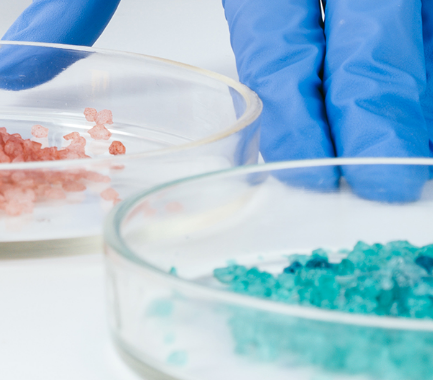Your contact
PENPET-Team - Hamburg

Laurens Rogowski
Sales
Tel. +49 (0) 40 - 675 7 99 80
sales@penpet.de
Get in touch with us.
Trimellitic anhydride (TMA)
Trimellitic anhydride (TMA) is an organic compound from the group of carboxylic acid anhydrides and is an important raw material for the chemical industry. The commercial production of the substance is based on two different large-scale processes. Trimellitic anhydride can be obtained either by oxidation of pseudocumene in air or by splitting off water from trimellitic acid.
The compound is an important starting material for the production of polyesters, polyurethane resins, water-soluble alkyd resins and aminoalkyd resins, lacquers, coatings and plasticizers for polyvinyl chloride (PVC), as well as hardeners for dyes and epoxy resins. In some plastics manufacturing processes, trimellitic anhydride can be used as a substitute for trimellitic acid.
At PENPET you can order the required amount of trimellitic anhydride (TMA) in an uncomplicated and sustainable way. We look forward to receiving your inquiry for an individual offer. The solids can be delivered in 25 kg sacks and in Big Bags of 500 kg or 1000 kg.
CAS no. 552-30-7
EINECS no. 209-008-0
Molecular formula: C9H4O5
Synonyms: Trimellitic anhydride, anhydrotrimellitic acid, 1,2,4-benzenetricarboxylic acid-1,2-anhydride, 1,2,4-tricarboxybenzene-1,2-anhydride, benzene-1,2,4-tricarboxylic acid-1,2-anhydride, 1, 3-dioxo-2-benzofuran-5-carboxylic acid, 1,3-dioxophthalene-5-carboxylic acid, Trimellitic Anhydride, TMA
Areas of application: Raw material for the production of polyesters, alkyd resins, polyurethane resins, varnishes, coatings, plasticizers for PVC and hardeners for epoxy resins and dyes
More Information
The structure of trimellitic anhydride (TMA) is derived from the structure of trimellitic acid, the anhydride of which it is. In the center of the compound is a phenyl ring, which gives it an unsaturated character and aromatic properties. Of the original three carboxylic acid groups of trimellitic acid, one is still preserved, so that trimellitic anhydride is still to be regarded as a carboxylic acid and can, for example, combine with alcoholic compounds to form an ester. The other two carboxylic acid groups of the acid, which are attached to adjacent carbon atoms of the phenyl radical, are linked with elimination of a water molecule and via a shared oxygen atom to form a cyclic structure, as is known from phthalic anhydride. The entire structure of the molecule is expressed in the synonymous name 1,2,4-tricarboxybenzene-1,2-anhydride. As an alternative to the preparation and derivation from trimellitic acid, the compound can also be built up by oxidation of pseudocumene.
Trimellitic anhydride (TMA) is an odorless solid under normal conditions, present in the form of colorless crystals and white flakes. The compound is hygroscopic and decomposes in water. Due to the resulting sensitivity to moisture, trimellitic anhydride must be stored in a dry place under exclusion of air. The compound is strongly acidic in aqueous solution. It only turns into a liquid melt at temperatures above 167 °C and boils at 390 °C.
Trimellitic anhydride (TMA) is very sensitive to moisture. However, the substance is chemically stable when stored dry and airtight. It is combustible, but difficult to ignite. The fine powder in which the compound is present represents a particular source of danger: If the dust is stirred up, explosive dust-air mixtures can form. Trimellitic anhydride should therefore be kept away from sources of ignition such as electrostatic discharges, sparks, open flames or hot surfaces. Dangerous and harmful gases such as carbon monoxide can be released when the substance is burned.
Dust from the compound takes in moisture from the environment and turns into an aqueous solution with a corrosive effect. Trimellitic anhydride (TMA) can therefore cause severe irritation and burns to the skin, respiratory tract and eyes. Serious damage and impaired vision are possible. After contact with the substance, the affected areas of the body should be flushed immediately with sufficient water to dilute and remove any acid residue. Medical treatment must then be arranged immediately.
Inhalation of trimellitic anhydride may cause temporary difficulty breathing, coughing, asthmatic symptoms, increased nasal discharge, headache and nosebleeds. Even serious damage to health such as pulmonary edema cannot be ruled out. Tolerance studies on animals have shown that oral ingestion of the compound causes severe damage. The possible consequences include irritation and chemical burns of the mucous membranes of the mouth and throat, but also perforations of the stomach and esophagus. In view of the health risks and the risk of explosion from dust-air mixtures of trimellitic anhydride, the whirling up of fine particles of the substance must be avoided at all costs and comprehensive occupational safety measures must be observed.
The compound is considered to be slightly hazardous to water and may be harmful to aquatic organisms. A penetration of trimellitic anhydride into open waters, soil and groundwater as well as the sewage system must therefore be prevented. The substance is not subject to official transport regulations.
